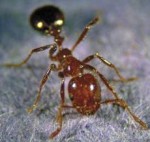USF Professor discovers fire ants play dead to survive

Fire ants create territories, care for their young and even fight to the death to defend their homes. But USF professor Deby Cassill and her Experimental Design in Biology class at the St. Petersburg campus have discovered another interesting quality: Fire ants can also play dead.
Cassill and her class of undergraduate students were studying the aggressive behavior of ants. While videotaping them, they noticed one ant attack and seem to kill another. However, after the attacking ant left, the other got up and walked away.
“I have never seen this behavior before and I don’t think anybody else has ever witnessed this behavior in any ant species,” Cassill said.
Cassill and the class discovered that younger fire ant workers fake death as a defense strategy against attacking colonies. Ants that pretend to be dead are four times more likely to survive an attack than older workers who choose to fight back.
The discovery was so stunning that two students in the class decided to conduct a directed study on the fighting behavior of ants, and some of the students have co-authored peer reviewed articles with Cassill on the subject for the scientific journal Die Naturwissenschaften.
“This ant playing dead was so interesting that it was worth its own research experiment and paper,” Cassill said.
Cassill and the class have posited two explanations as to why the ants fake their deaths. One was to ensure the survival of valuable younger workers to tend to the queen and increase the colony’s size. Another was that newly hatched ants, more apt to injuries in battles because of their soft external skeletons, are less aggressive.
Cassill, a biologist specializing in evolutionary biology and the evolution of social behavior, said ants and human beings are similar in more ways than one.
“Ants are one of the few social species that are anatomically very different from humans but a lot of their social behavior parallels human behaviors,” Cassill said. “So what I bring to the research on social behavior is kind of a psychological point of view. I’m interested in what the individual does and how they interact with others.”
Each student also focused individual research on other types of ant behavior, including napping patterns, decision-making, hunger and aggression.
Some of these studies have been published in other scientific journals, including the Journal of Insect Behavior and Insectes Sociaux.
Devon Singh, one of the students in the class, researched ant-to-ant aggression, ant-to-human aggression and the overlapping tendencies of ants’ mandibles – the pair of appendages near the insects’ mouths. During his study, Singh hand-picked ants of different sizes.
“This meant leaning over hundreds of thousands of ants and using ‘no-kill’ tweezers to select different sizes,” Singh said. “The task was back-breaking.”
To analyze their mandibles, Singh temporarily put the ants to sleep using the cold temperature of a freezer. Singh published his work in the Journal of Insect Behavior.
“I credit this course with helping me enhance my problem-solving skills,” Singh said. “Given the fact that most undergraduate student research consists of cleaning lab tools, I am extremely grateful to have been given the honor of working under the wonderful Dr. Deby Cassill.”
Cassill said the course will likely be offered again sometime next school year.
“This is a real opportunity for students to do hands-on research,” Cassill said. “I use ants to catch their interest, but they walk out learning how to think about data in a way that a lot of graduate students have not yet learned. It’s a phenomenal class.”






